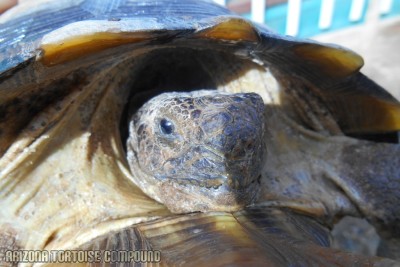Description and Identification
With a large shell up to 15" in length, this land tortoise has a domed carapace that is marked by distinct growth rings. Coloration can be horn, orange-brown, gray-brown, dark gray, or nearly black. The underside of the shell is usually tan or yellow. The tail is short. The hind limbs are also short but rounded and thick. The forelimbs are flattened for digging and longer than the hind limbs. The forelimbs are armored with large, thick scales. The head is relatively small and rounded. In males, the gular shields of the plastron extend out underneath the throat more so then the females. This tortoise has shorter gular shields and a more narrow shell-width than the similar looking Agassiz's Desert Tortoise (Gopherus agassizii).
-

-

-

-
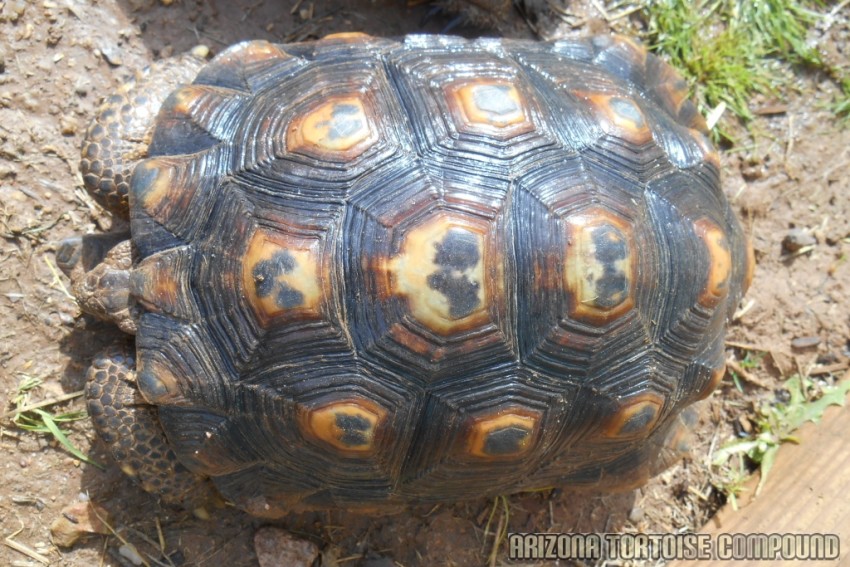 Alternate Carapace: Center of each scute still mostly light.Alternate Carapace: Center of each scute still mostly light.
Alternate Carapace: Center of each scute still mostly light.Alternate Carapace: Center of each scute still mostly light. -
 Left - Gopherus morafkai (Sonoran Desert Tortoise); Center - Gopherus agassizii (Mojave Desert Tortoise); Right - Gopherus berlandieri (Texas Tortoise)Left - Gopherus morafkai (Sonoran Desert Tortoise); Center - Gopherus agassizii (Mojave Desert Tortoise); Right - Gopherus berlandieri (Texas Tortoise)
Left - Gopherus morafkai (Sonoran Desert Tortoise); Center - Gopherus agassizii (Mojave Desert Tortoise); Right - Gopherus berlandieri (Texas Tortoise)Left - Gopherus morafkai (Sonoran Desert Tortoise); Center - Gopherus agassizii (Mojave Desert Tortoise); Right - Gopherus berlandieri (Texas Tortoise) -

-
 Right - Gopherus morafkai (Sonoran Desert Tortoise); Center - Gopherus agassizii (Mojave Desert Tortoise); Left - Gopherus berlandieri (Texas Tortoise)Right - Gopherus morafkai (Sonoran Desert Tortoise); Center - Gopherus agassizii (Mojave Desert Tortoise); Left - Gopherus berlandieri (Texas Tortoise)
Right - Gopherus morafkai (Sonoran Desert Tortoise); Center - Gopherus agassizii (Mojave Desert Tortoise); Left - Gopherus berlandieri (Texas Tortoise)Right - Gopherus morafkai (Sonoran Desert Tortoise); Center - Gopherus agassizii (Mojave Desert Tortoise); Left - Gopherus berlandieri (Texas Tortoise) -

-

-
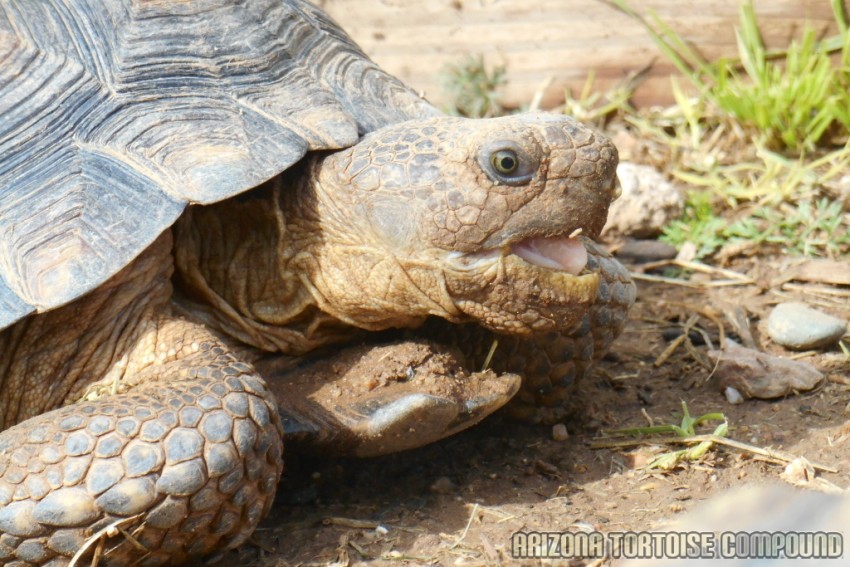
-

-
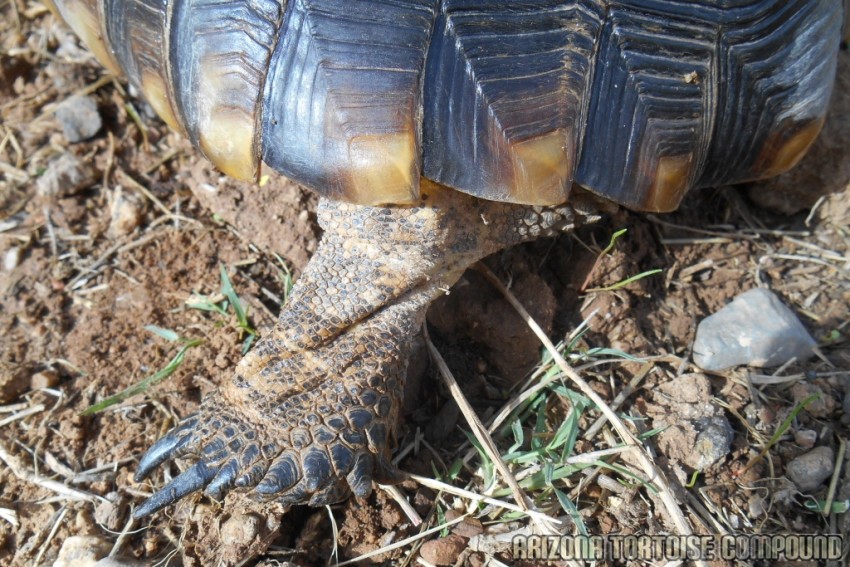
-
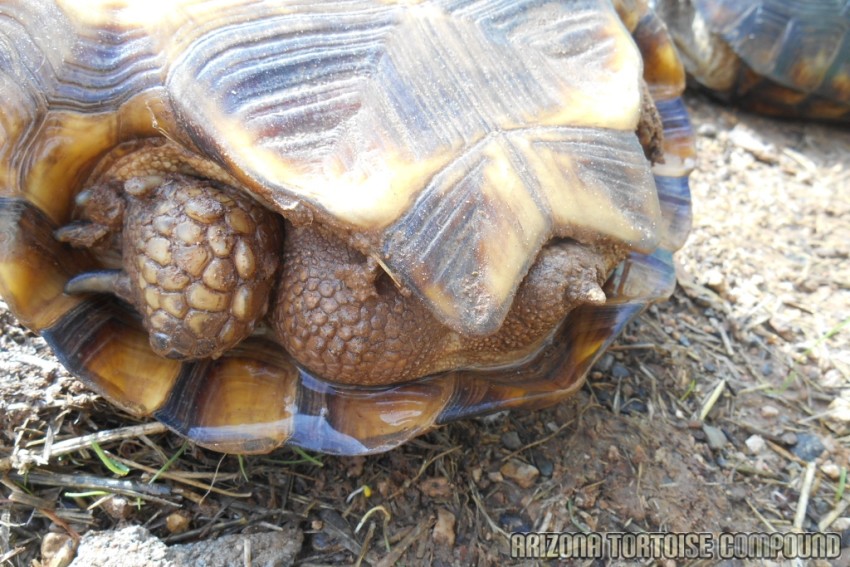
Distribution
Gopherus morafkai occurs east of the Colorado River in Arizona as well as in the states of Sonora and Sinaloa in Mexico. These tortoises occur in elevations ranging from near sea level to just over 5,000 feet. One of just four members of the Testudinidae family in North America, the desert tortoise inhabits the desert ecosystems of the southwestern United States and northern Mexico. Home range sizes for males can overlap multiple female ranges.
Native Habitat
The Sonoran Desert Tortoise inhabits desert ecosystems such as desert scrub, semi-desert grasslands and prefers rocky slopes and bajadas. Populations in northwestern Arizona inhabit more moderate terrain such as gentle bajadas and low valleys. Desert Tortoises construct burrows under shrubs and rocks. Desert washes are important to this species as they provide exposed banks for them to locate burrows and use the sporadic vegetation for thermal cover.
Wild Diet
Desert Tortoises are herbivores feeding on grasses, herbs, annual wildflowers, and new growth of cacti, as well as their fruit and flowers. Rocks and soil are also ingested, perhaps as a means of maintaining intestinal digestive bacteria as a source of supplementary calcium or other minerals. These tortoises are able to conserve water due to their large urinary bladder. Most of their water intake comes from the plants and cacti they consume but, during monsoon rains, they can be found drinking from pool of water. Gopher tortoises are scavengers and will also feed on small berries, fruits, carrion, and excrement.
Behavior
Sonoran Desert Tortoises are most active in Spring and Fall months. They can be found foraging or traveling between burrows, and possibly mate-seeking during dawn and dusk. They are able to live where ground temperatures may exceed 140 degrees F because of its ability to dig underground burrows to escape the heat. It is one of the most elusive inhabitants of the desert, spending up to 95% of its time under ground to escape the heat of the summer and the cold of winter. They live in burrows, which they dig themselves. These burrows can be 3-6 feet deep. They will spend November through February in a torpid or dormant state in their underground burrows.
Reproduction
Breeding can be seen during the Spring and Autumn months. During the breeding season male Sonoran Desert Tortoises will develop glands underneath the chin called, chin glands. These prominent chin glands produce a secretion which aids in sex recognition and often evokes combative behavior between males. Males will approach the female while head bobbing, he will then circle the female and few times, maybe bite at her limbs, then the male will mount the female from behind and start procreating. After some time the female will then choose either a sunny spot nearby or a sandy mound in front of her burrow to lay between 3 to 15 eggs. The eggs then hatch from 70 to 100 days later. Once hatched the baby tortoises spend most of their time in their mother's burrow until they learn to dig their own.
This Care Guide is an external Care Guide. While it is possible this care guide may not be for the exact species you were looking for, it provides information suitable for your species. This Care Guide link will take you away from theTurtleRoom. We only link to care guides we trust. Thanks for visiting theTurtleRoom.org.
Care GuideIf you would like to contribute to the photo gallery of any turtle or tortoise species, please email us at [email protected]. You will be credited for any photos you contribute.
| Gopherus morafkai |
| (Murphy, Berry, Edwards, Leviton, Lathrop, and Reidle, 2011) |
| IUCN Red List: |
 |
| Vulnerable A1acde+2cde; E (1996) |
| Order: | Testudines |
| Suborder: | Cryptodira |
| Superfamily: | Testudinoidea |
| Family: | Testudinidae |
| Genus: | Gopherus |
| species: | morafkai |
| Other Common Names: |
| Morafka’s Desert Tortoise |
| Old Taxonomy: |
| Gopherus agassizii |
| CITES: | Appendix II |
| U.S. Legal Status: |
| Candidate for ESA listing, Arizona Residents are allowed one per person, per household. Take illegal in entire native range (Arizona). Breeding, purchasing and sales are prohibited. |
Author:
Editors: Stephen J. Enders, Anthony Pierlioni, Chris Leone, Andrew S. Weber, Ben Forrest, and Andrew Hermes
Sources
Disclaimer: The Species Profiles - Natural History, Care Guide, and Photo Gallery database is an educational resource. It does not cover all Chelonian species in the world, nor does it include all the latest scientific information about the species covered. Though we edit our accounts for accuracy, we cannot guarantee all information in those accounts. While theTurtleRoom's staff and contributors provide references to books and websites that we believe are reputable, we cannot necessarily endorse the contents of references beyond our control.

This work by theTurtleRoom is licensed under a Creative Commons Attribution-NonCommercial-ShareAlike 4.0 International License.




